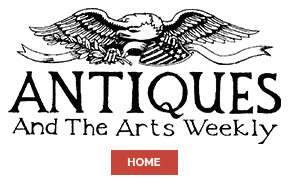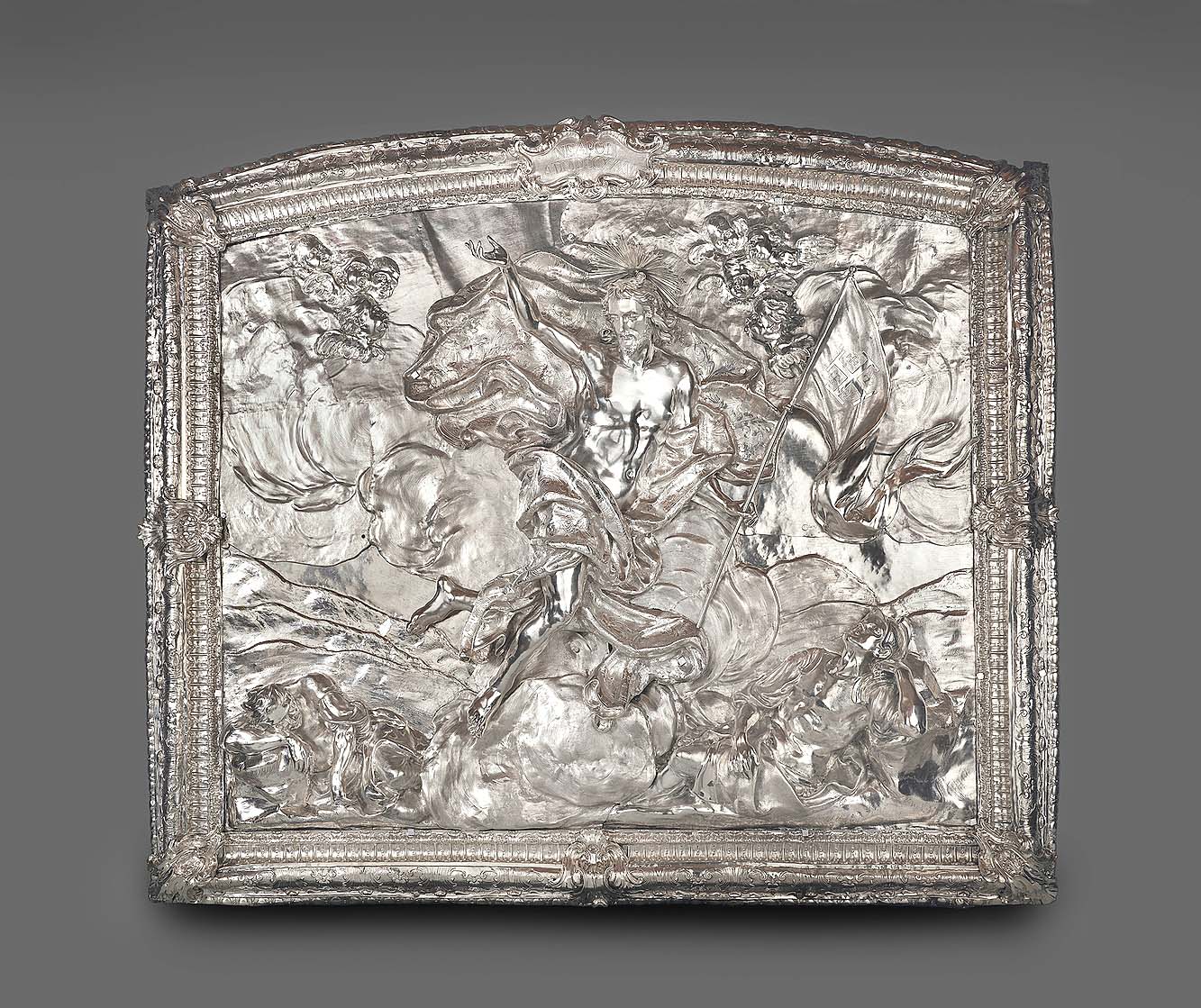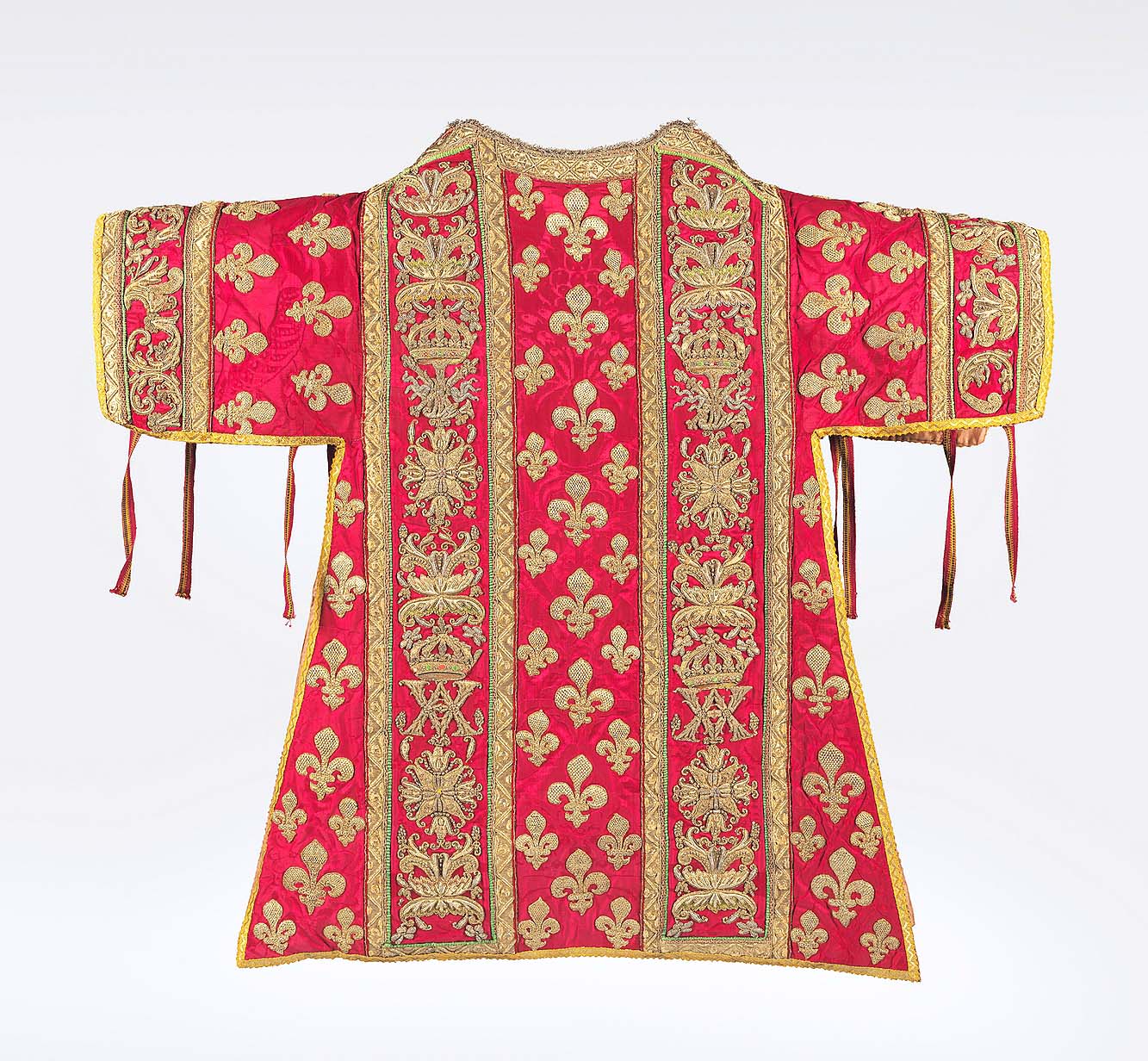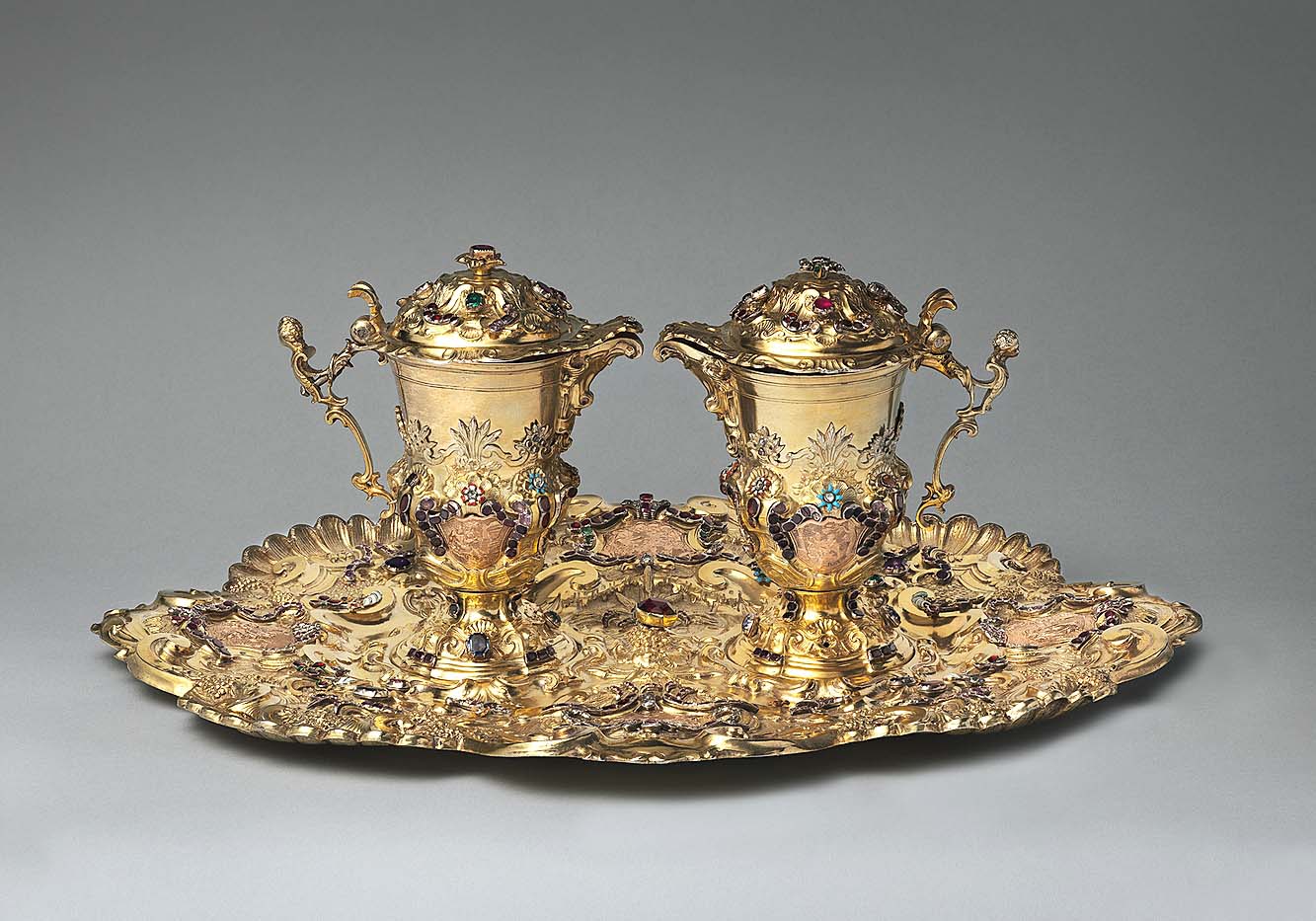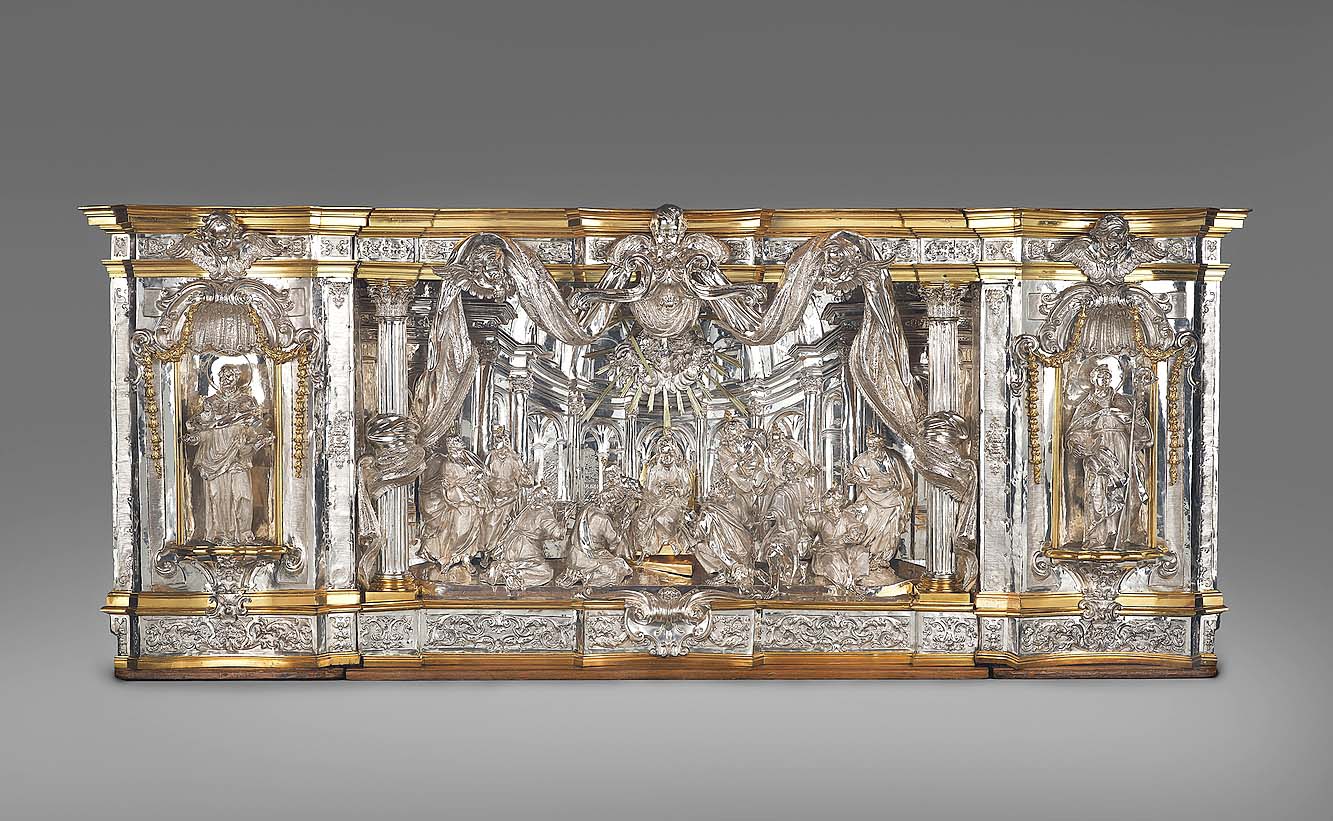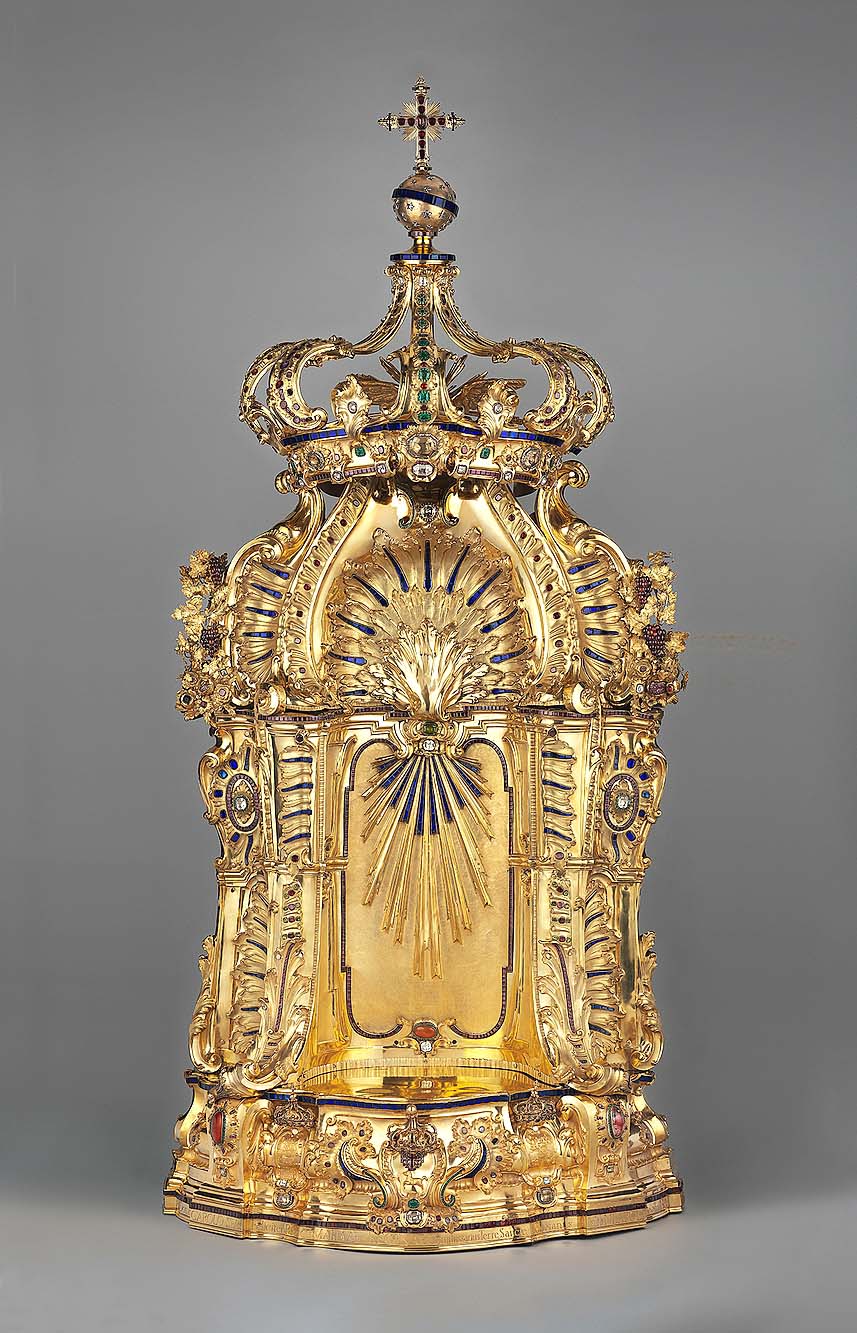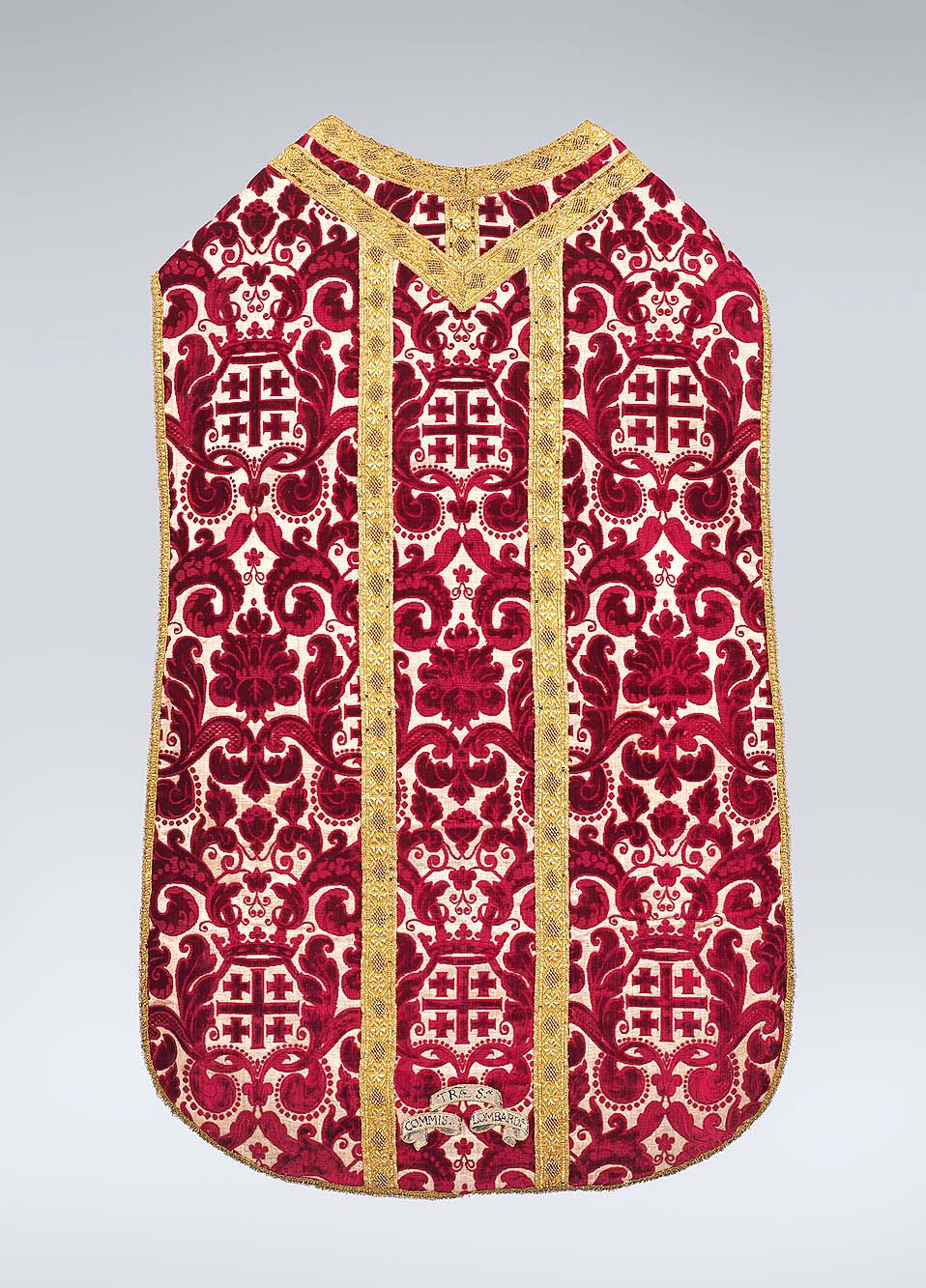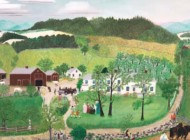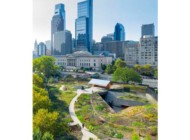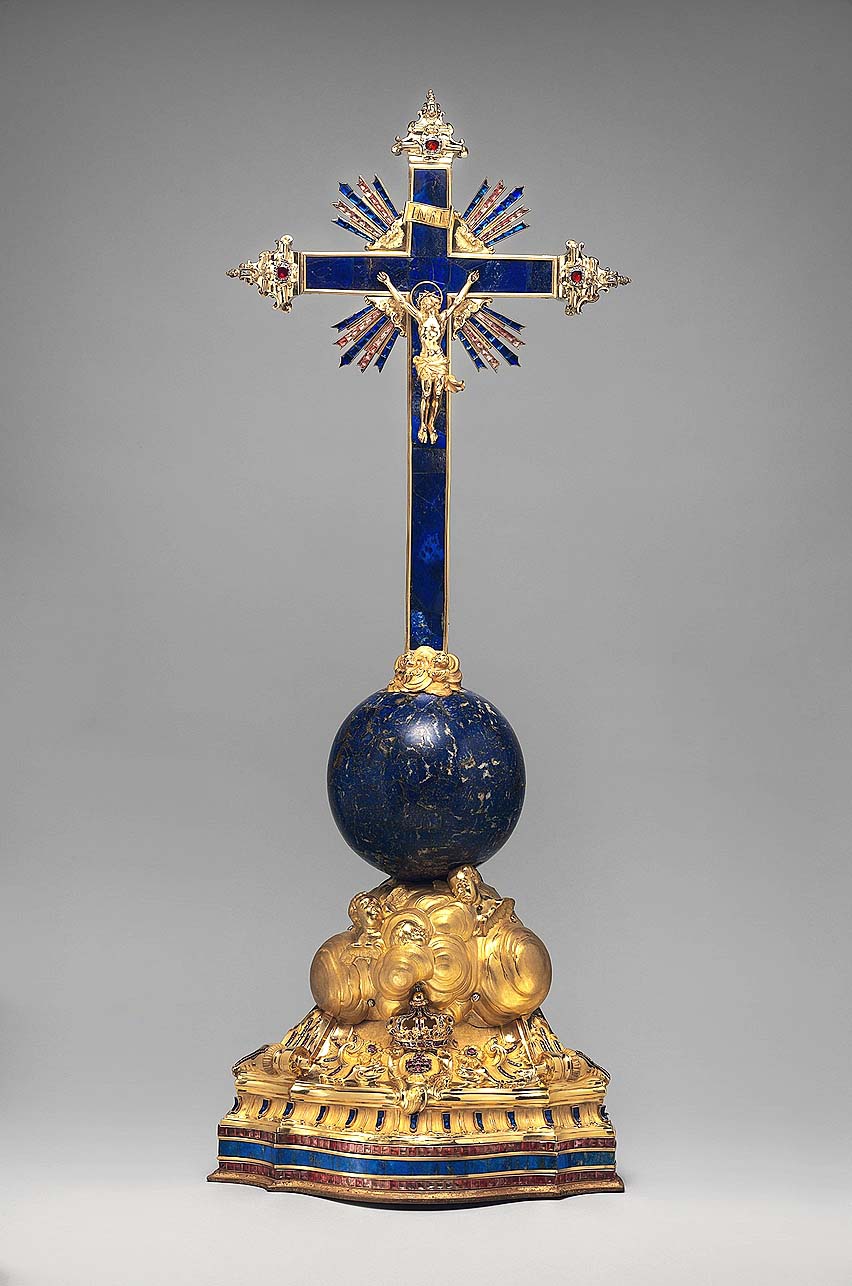
Crucifix, Naples, 1756, gold, lapis lazuli, almandine garnets, rubies, emeralds, diamonds, quartzes and glass, 35½ by 13½ by 9 inches. Terra Sancta Museum, Jerusalem. Joseph Coscia, Jr, photo.
By James D. Balestrieri
NEW YORK CITY — Perhaps even more intriguing than lost treasure, the kind that requires parchment maps and leads to rollicking adventure stories, is the idea of treasure hiding in plain sight, treasure neglected, perhaps even forgotten. A story of treasure hiding in plain sight — and a magnificent treasure it is — lies at the heart of “To the Holy Sepulcher: Treasures from the Terra Sancta Museum,” the exhibition on view at the Frick Collection in New York from October 2 through January 5.
More than 40 objects will be on view, including gold, silver and gem-encrusted liturgical objects and church vestments in velvet and damask featuring sumptuous designs and embroidery. The exhibition tells the story of the rise of St Francis, the rise and mission of the Franciscan Order in the Holy Land, the development of the Treasure of the Custody of the Holy Land and their centuries’ long oversight of sacred sites in Jerusalem, especially the Church of the Holy Sepulcher, long held to have been the location of Christ’s crucifixion, burial and resurrection.
In the centuries following the establishment of the Franciscans in Jerusalem — centuries in which relations between Christians and Muslims, who ruled there, as well as relations between various Christian sects, were often fraught with conflict — the various Catholic kingdoms of Europe sent rich gifts as alms, competing, as it were, for the favor of both Rome and heaven, in acts of conspicuous dispensation. In addition to money, books, cloth and medicines, the Kingdoms of France, Spain, Naples and Sicily, Portugal, the Holy Roman Empire and the Republics of Venice and Genoa commissioned the finest metalworkers, jewelers and textile makers to create objects intended to serve the liturgical needs of the Church of the Holy Sepulcher while projecting the wealth and power of the donors through the weaving of names of donors and coats of arms into the designs.
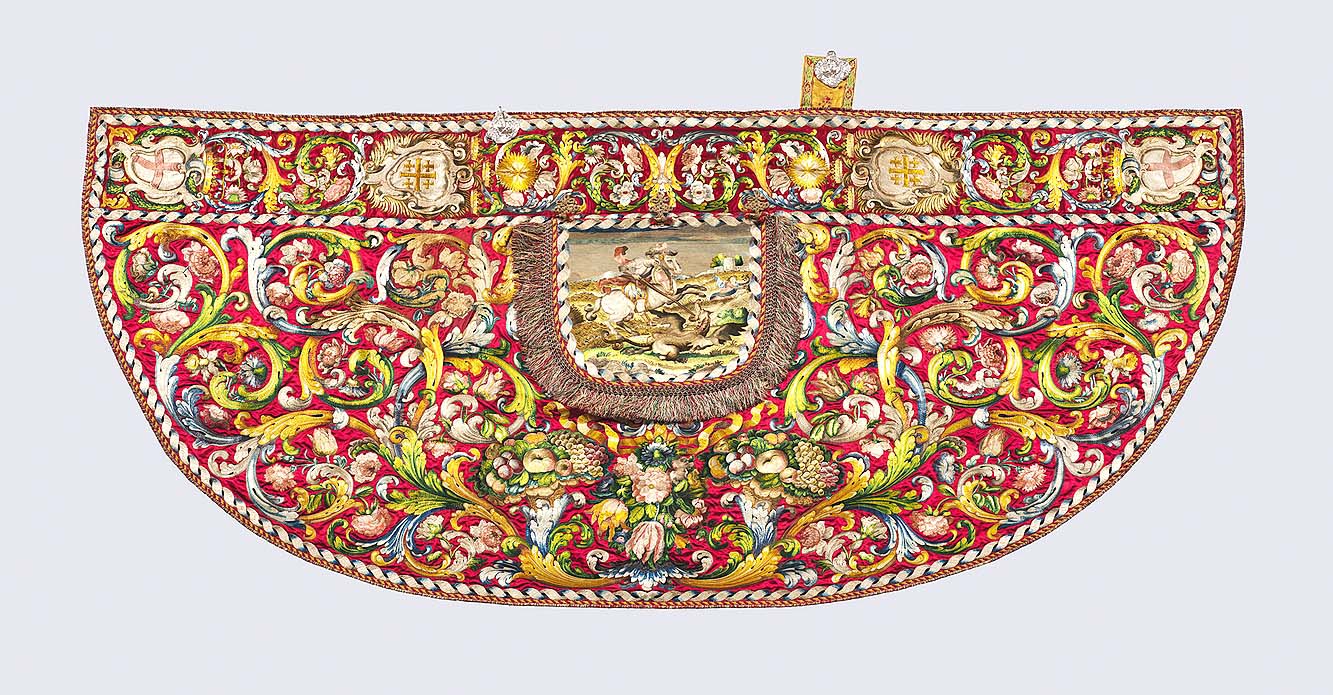
Cope of the red pontifical set of vestments of Genoa, probably the workshop of Domenico Piola (1628-1703), Genoa, 1686-97, satin ground, silk thread and painting on silk, 54-1/8 by 110-13/16 inches. Terra Sancta Museum, Jerusalem. Joseph Coscia, Jr, photo.
The comprehensive catalog that accompanies the exhibition opens with the kinds of notes that tantalize treasure hunters — and archaeologists — in two books from the 1850s by American attorney, traveler, angler and author W. C. Prime: Boat Life in Egypt and Nubia and Tent Life in the Holy Land. Prime, who would become one of the founders of the Metropolitan Museum of Art, had somehow, perhaps from a Franciscan monk in France, learned of the treasures of the Holy Sepulcher, and inquired about them. As he wrote, “We were led into a remote room where there was nothing to attract attention, nor would a stranger have supposed that it contained such treasures as we found in drawers, and cases and closets.… In one corner of a large room lay a huge pile, which appeared like the corner of a tinman’s shop, and had not my attention been especially directed to it, I should have thought it a collection of old tinware, pans and water leaders, gutters, spouts and such chandeliers as I remember to have seen in old times in the church at Liberty, in Sullivan county, when I was taking trout on the Willoweemock.
This proved to be a heap of solid silver, more in weight we believed than a half ton, consisting of various church ornaments, and especially of huge candelabra, standing over seven feet high from the floor, wrought in beautiful shapes of the solid metal and heavier than one man could well lift.”
Fast forward to 1980, to a visit to the Custody of the Holy Land, part of the St Savior Monastery, by Alvar González-Palacios, who picked up the trail Prime had hinted at, augmenting it with documents he had unearthed in Naples. After a first rebuff, González-Palacios returned. He writes, “Two evenings later, I rang again at the gate. After making me swear that I would not reveal to anyone the location of what I was about to see, Brother Maurilio ushered me into a secluded room in St Savior, where I beheld, incredulously, a mountain of gold, silver and precious stones in a corner.”
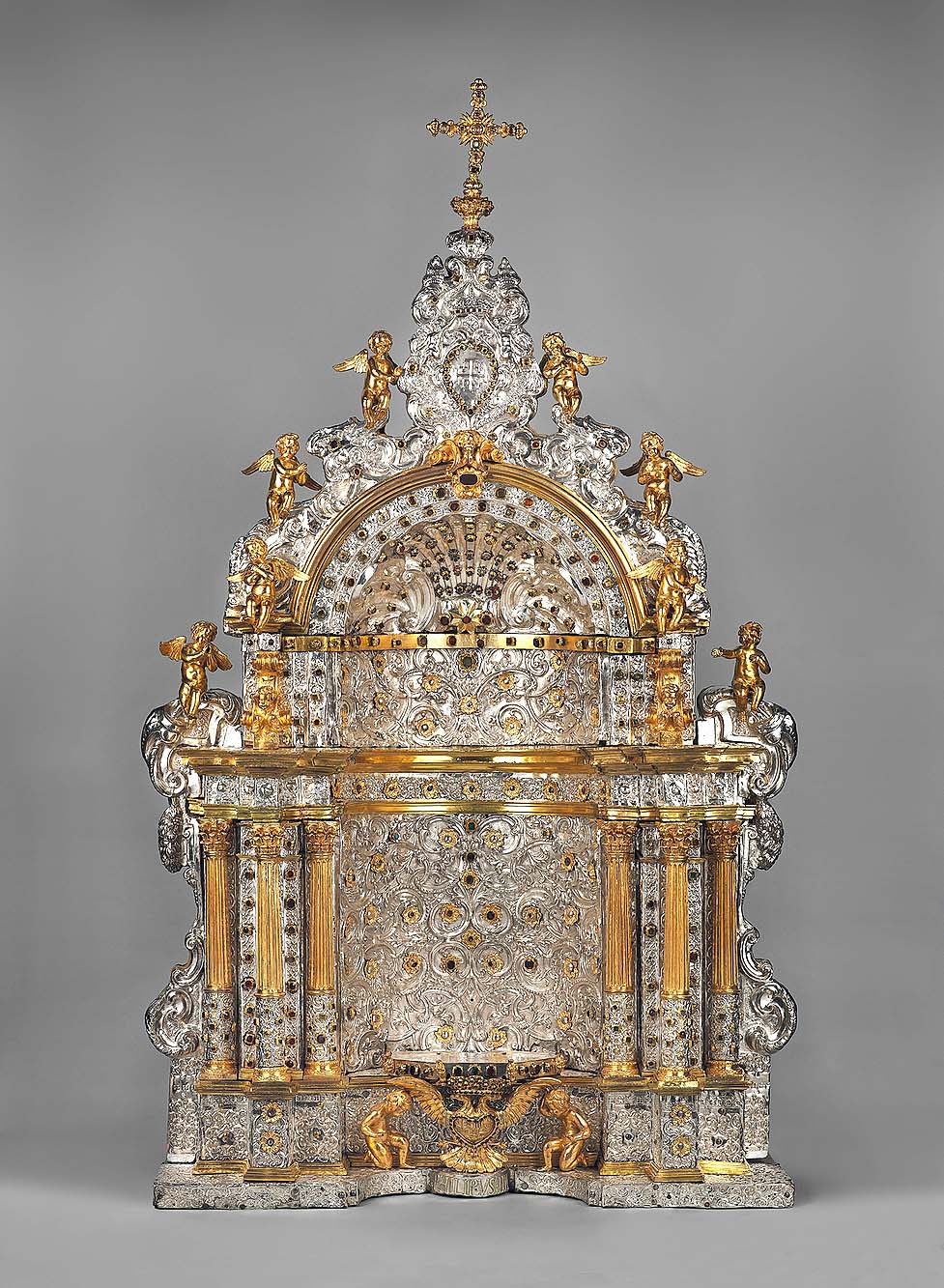
Throne of Eucharistic Exposition by Pietro Juvarra (circa 1609-1705) and his sons Eutichio (d 1682) and Sebastiano (d 1701), Messina, 1665, cast, chased, embossed and partially gilt silver and precious stones, 73¼ by 43½ by 15-15/16 inches. Terra Sancta Museum, Jerusalem. Joseph Coscia, Jr, photo.
From that moment, the treasures of the Holy Sepulcher have attracted the interest of a wide variety of scholars. That interest, in turn, has added to the story, making the exhibition a celebration of the opening of the new Terra Sancta Museum in Jerusalem, which will offer a permanent home for the treasures and extraordinary opportunities to display them in context as well as in dialogue with other objects from other cultures of the Middle East.
The journeys of the objects from their homelands to Jerusalem are themselves stories. Sent by sea, some of the alms succumbed to storms, the predations of pirates and competition from rivals. Addressing this, Frick deputy director and the Peter Jay Sharp chief curator, Xavier F. Salomon, one of the organizers of the exhibition, stated, “This exhibition represents a completely unique opportunity for visitors, building on the Frick’s successful past presentations highlighting masters of European decorative arts. Displayed for the first time in the United States, the exquisite objects in the show are rare survivals, as similar objects were often severely damaged, melted down or otherwise lost — nothing like them survives in the countries in which they were created.”
Even arrival of the objects in Jerusalem failed to guarantee their safety and not all of those in the exhibition eluded violence. Animosity between Christian sects was not infrequent. As the catalog recounts, on the eve of Palm Sunday, April 2, 1757, “a revolt organized by the Greek clergy against the Latins took place inside the basilica, with a ransacking of the chapels occupied by the friars, who were driven out after being physically attacked.” Eventually, “remnants of the precious gold and silver pieces that had been destroyed during the sack of Palm Sunday were sent to Venice to be melted down and used to make 66 silver lamps and the monumental pair of torchères today in the St Savior church.” Still, the history of these pieces seems to be contained in them, as figures from a lamp sent from Tuscany by the Medici, a lamp destroyed in the 1757 sack, appear to have been repurposed in Venice for the torchères.

Torchère (one of a pair) by the Al San Lorenzo Giustinian Workshop, Venice, 1762, cast, chased and repoussé silver, gilded in parts, 96-1/6 by 27-9/16 by 24-13/16 inches. Terra Sancta Museum, Jerusalem. Joseph Coscia, Jr, photo.
This era of alms-giving reached its zenith from the beginning of the Seventeenth Century through the close of the Eighteenth. It is no accident that the fabrication of the myriad gold and silver objects, the treasures of the Holy Sepulcher, stem from the mineral wealth of the colonies in the Americas. As such, it is unsurprising to find that Spain was the leading donor and that some of the largest, most ornate and precious objects in the exhibition are of Spanish origin. A magnificent Throne of Eucharistic Exposition, donated by Philip IV, King of Spain from monies taken from the Kingdom of Sicily. At the time Spain included Sicily; therefore, the throne, a creation of the Juvara family in Messina, Sicily, echoes Baroque Sicilian architectural forms in its design, adorned as it is with more than 500 semi-precious stones.
It’s odd to contemplate that beautiful objects such as the vestments with the coat of arms of King Louis XV of France could ever have been tucked away in drawers or piled in corners. But perhaps it isn’t so odd when we recall that it has been the Franciscans, formed by St Francis of Assisi — whose humility and unconcern for the riches of this world led to his sainthood — who have cared for the treasure. In the Holy Land, the Franciscans have been — and still are — busy, healing, teaching, trying to maintain their precarious toehold and build bridges even as deep and ancient divisions burn them.
Perhaps, after viewing the neglected and all-but forgotten treasures from the Terra Sancta, we should remember one of the Frick’s own great treasures, Giovanni Bellini’s painting, “St Francis in the Desert.” Francis visited the Holy Land and met with Sultan Al-Malik al-Kâmil in Damietta, Egypt in 1219. He didn’t convert the Sultan. The Sultan, however, tried to shower Francis with gifts. When he disdained them, the Sultan was amazed. And so, a question arises. In the end, did a measure of Franciscan benign neglect act as protection for the unplundered objects in “To the Holy Sepulcher: Treasures from the Terra Sancta Museum”?
The Frick Collection is at 1 East 70th Street. For information, 212-288-0700 or www.frick.org.
